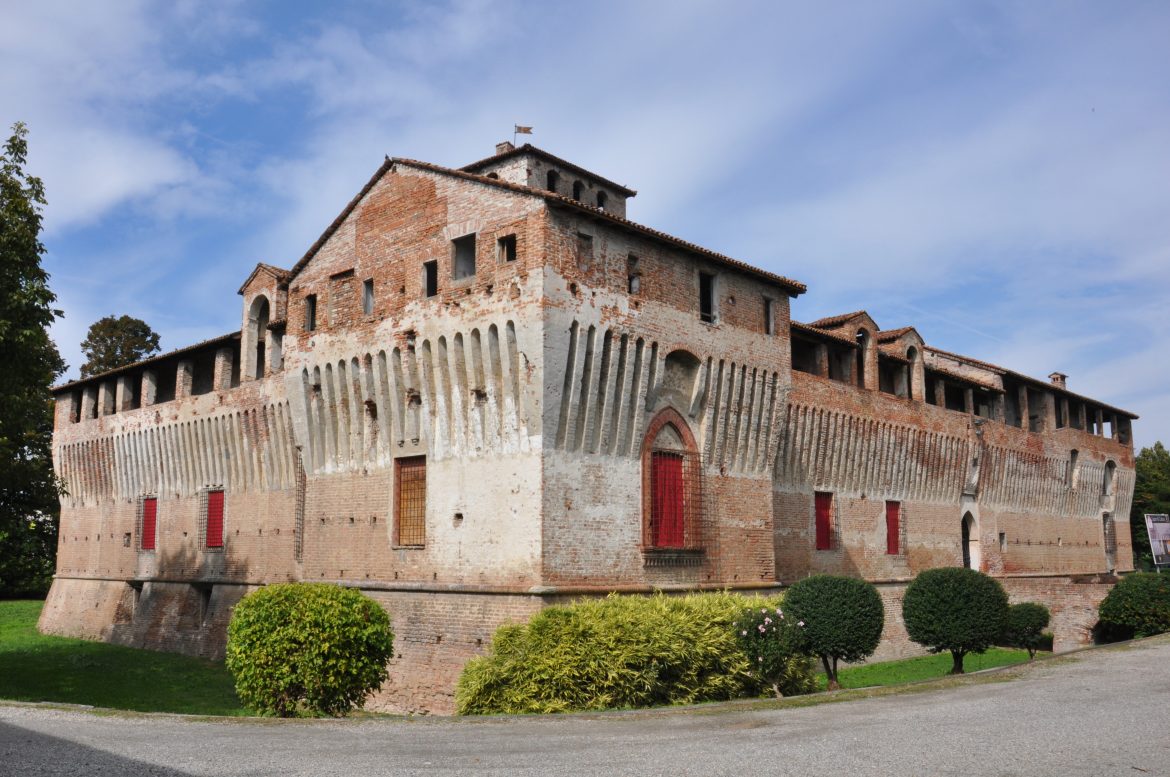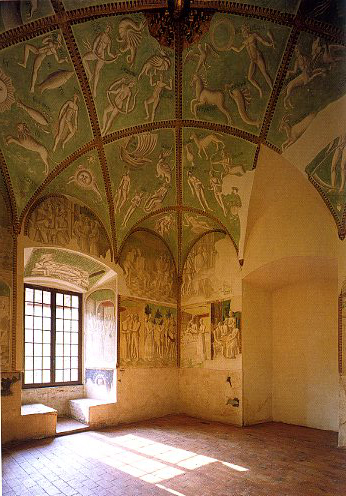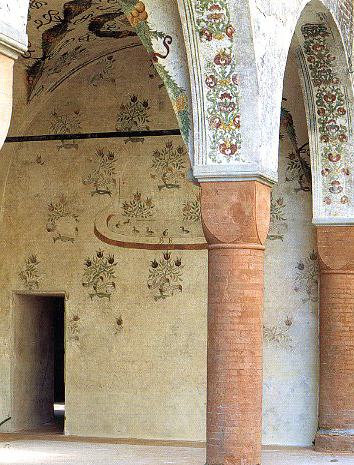A small town along the “Culatello Road”, between the banks of the River Po and the meanders of the River Taro, Roccabianca is probably the medieval village of “Rezinoldo” or “Arzenoldo”, which Dederico Barbarossa gave in battle to the Pallavicino family in the 12th century.
The town’s main symbol is the monumental 14th century fortress, built by noble Pier Maria Rossi for his beloved Bianca Pellegrini.
A yearning for romance caresses the hamlet of Roccabianca, softened by the intrigue of a relationship linking two hearts. It would appear that the noblewoman gave the name by which the town is known today. Another interpretation of the name is from the fact that the fortress was originally completely painted white.
In 1450, Pier Maria Rossi started construction work on the fortress, which was completed in 1465, and in 1467 the count gave it to his beloved. The fortress changed hands many times, and was bought in 1968 by the Scaltriti family, owners of a distillery, who opened it up to the public in 2003. It is also known as the “Castle of lovers and enamoured”, but also as the “Castle of Liquors and Spirits” with the distillery museum now in the old cellars. On the visit you will learn about Pier Maria’s long love story, how the entire castle stems from the dedication to Bianca: a peregrine falcon rests on the tower, and at its side there are two wayfarers carrying bags. Loyalty, love, dedication, patience are all virtues sung by the frescoes. Recent restorers have worked to highlight the high quality of the frescoes, as well as the coats of arms on the porticoes opposite the famous “Griselda Room” with its modern reconstruction of the series of paintings inspired by the Decameron.
In the nearby Minozzi square you can see the portico with its monumental entrance archway, built between the end of the 1600s and the start of the 1700s. Nearby is the church of Saints Bartholomew and Matthew: it was built on with a late-Romanic structure between 1576 and 1577, then rebuilt in Baroque style towards the end of the 17th century, and entirely decorated internally in rococo style in 1723.
The Teatro Arena del Sole has had an interesting history. It was inaugurated as an open-air arena in 1946, but was subsequently covered and turned into a cinema. It was designated as a warehouse around 1980 to store furniture, then as a gym, and ultimately closed in 1995. It was bought in 2006 by the Municipality who then completely restored it and opened it to the public. When you enter you will find a surprise: nine surviving statues from a famous monument in Parma dedicated to Giuseppe Verdi. In celebration of 100 years since his birth, the city of Parma decided to pay homage by ordering the construction of a monument worthy of his name. The architect Lamberto Cusani was put in charge of the project, and construction started in 1913 in the square in front of Parma station. The work was immense, featuring 27 columns in a semi-circle made from granite and bronze, sculpted by Ettore Ximenes. The monument was hit by allied bombs in May 1944 during the Second World War. Despite the damage not being particularly great, it was decided that it should be dismantled. The large central altar was saved, now located in Piazzale della Pace in Parma, next to the Palazzo della Pilotta. Of the statues that were on the columns, some were saved, yet some were stolen or thrown into the river. Only nine survived, which were taken to the Arena del Sole theatre.
Roccabianca is also home to many culinary delicacies, and in fact is one of the four stops during “November Porc”, one of the most indulgent food festivals in Italy, which also sees stops in Sissa, Polesine and Zibello each weekend in November.
A few kilometres from Roccabianca is Fontanelle, a small hamlet which twists and turns along a tree-lined avenue, famous for being the birthplace of the writer Giovannino Guareschi, father of Don Camillo and Peppone. The lowlands were home for Guareschi, who set his “Little World” here, on the “wedge of land between the Po and the Apennines”. His birth house is on the right-hand side of the piazza, where you can also find a bronze bust of Giovanni Faraboli, a famous trade unionist who, it is said, inspired Guareschi for the figure of mayor Peppone.
Not far from Roccabianca is Ragazzola. Archaeological discoveries would place the birth of the town in the Roman period, perhaps as a resting place for wayfarers or soldiers. Legend surrounds the origin of its name, which may hark back to a terrible flood which cost the lives of everyone except one ‘lone girl’ [‘ragazza sola’]. As time has gone by, the religious tradition has taken root in the town, with the Church of St Peter Apostle built in 1432, and then rebuilt in Baroque style in 1680.
Roccabianca is also a departure point for an itinerary to discover fortresses and castles in the lowlands, enshrouded in legends, art and culture. Roccabianca is linked with San Secondo, again thanks to Pier Maria Rossi, who also enlarged and improved the fortress in San Secondo, which still bears the name Rocca dei Rossi.
Nearby in Soragna, the Rocca Meli Lupi welcomes you, taking the name from the princes who have lived there since 1385, while in Fontanellato you will find Rocca Sanvitale which hosts marvellous frescoes dating back to 1523, painted by Francesco Mazzola, a painter better known as “Il Parmigianino”.


